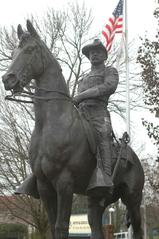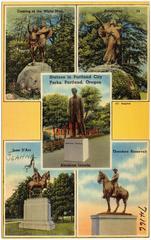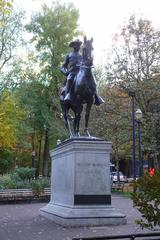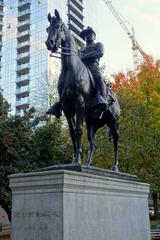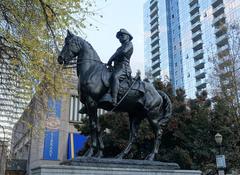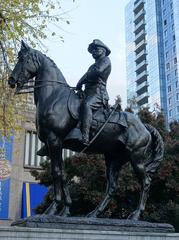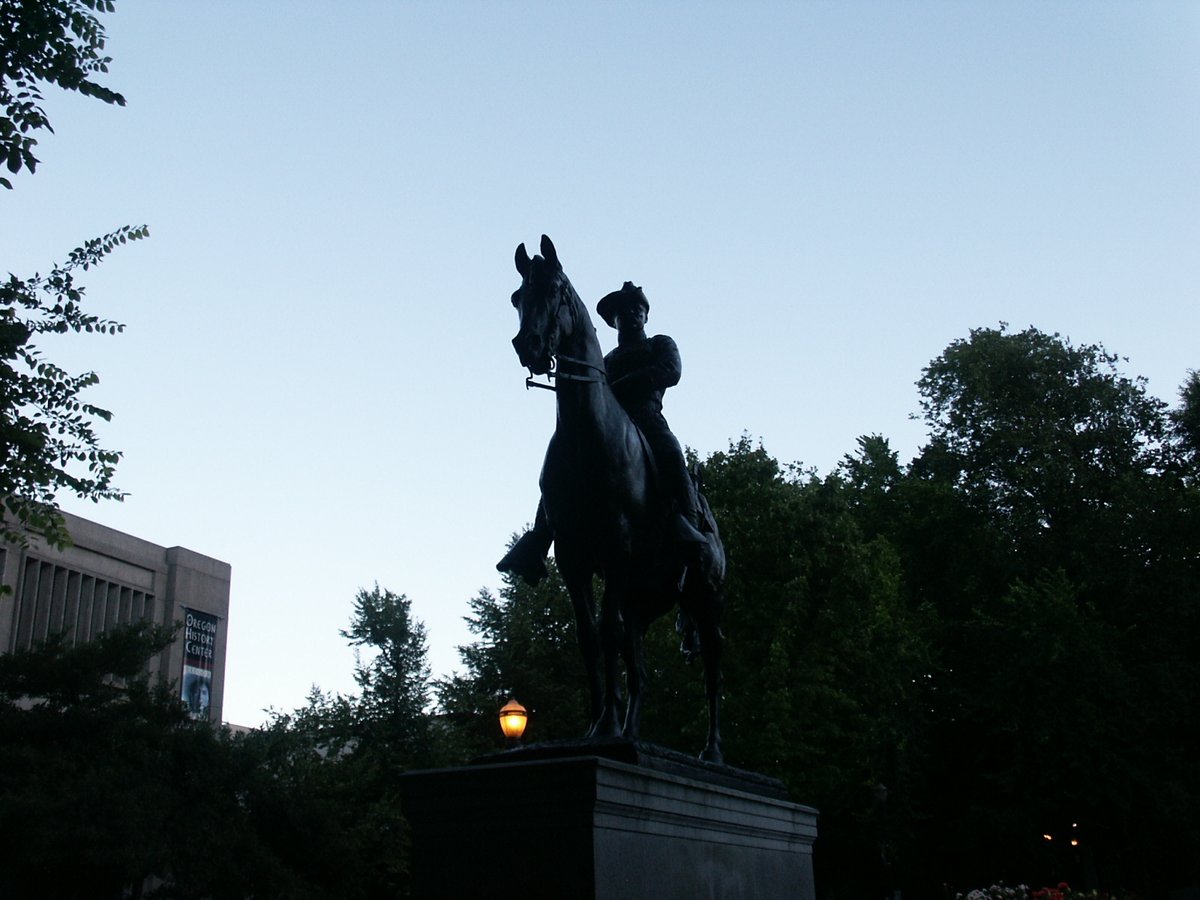
Theodore Roosevelt Rough Rider Statue Portland: Visiting Hours, Tickets, and History
Date: 14/06/2025
Introduction
The Theodore Roosevelt Rough Rider statue in Portland, Oregon, is a complex and significant landmark that embodies the city’s evolving relationship with American history, public art, and civic memory. Commissioned in the early 1920s to honor Roosevelt’s leadership during the Spanish–American War, the statue once stood in the South Park Blocks near the Portland Art Museum. Over nearly 100 years, it became a focal point for commemoration, controversy, and community dialogue. This comprehensive guide explores the monument’s origins, artistic and cultural significance, controversies, and practical visitor information, including current status, accessibility, and nearby attractions. Whether you are a history enthusiast, student, or visitor to Portland, this article will provide the insights you need to understand and engage with the legacy of the Theodore Roosevelt Rough Rider statue.
Contents
- Origins and Commissioning of the Theodore Roosevelt Rough Rider Monument
- Artistic Features and Symbolism
- Historical Context and Dedication
- The Monument’s Role in Portland’s Civic Identity
- Restoration, Preservation, and Future Prospects
- Visiting Information: Hours, Tickets, Accessibility, and Attractions
- Frequently Asked Questions (FAQ)
- Conclusion and Recommendations
- Sources
Origins and Commissioning of the Monument
The Theodore Roosevelt Rough Rider statue was commissioned in 1922 as a gift from Dr. Henry Waldo Coe, a prominent Portland physician and friend of Roosevelt. Dr. Coe sought to honor Roosevelt’s legacy as a statesman, conservationist, and the dynamic leader of the Rough Riders during the Spanish–American War. The commission reflected a broader early-20th-century movement to memorialize national figures and shape public memory through monumental art (Portland Parks & Recreation; Theodore Roosevelt Center).
Renowned sculptor Alexander Phimister Proctor, known for his equestrian sculptures and depictions of the American West, was selected to create the statue. Cast in bronze in Brooklyn, New York, the statue was installed at the entrance to Washington Park and dedicated on November 11, 1922 (Smithsonian Institution).
Artistic Features and Symbolism
Proctor’s monument depicted Roosevelt astride a rearing horse, clad in his Rough Rider uniform—a powerful image of vigor, leadership, and the mythos of the American frontier. The statue, standing 12 feet tall atop a granite base and reaching nearly 20 feet in total height, was oriented to face downtown Portland, symbolizing Roosevelt’s forward-looking vision and connection to the West.
The equestrian format evoked classical heroic traditions, while Proctor’s detailed realism captured the energy and spirit of both Roosevelt and his horse. The base bore Roosevelt’s name, presidential years (1901–1909), and a dedication to his leadership and service (Smithsonian Art Inventories).
Historical Context and Dedication
The statue’s dedication on Armistice Day, November 11, 1922, drew thousands, including war veterans, civic leaders, and Roosevelt’s family members. The parade featured children placing roses at the statue’s base, underscoring themes of valor, patriotism, and unity (Oregon Encyclopedia). The monument quickly became a local landmark, hosting civic celebrations and serving as a symbol of Portland’s admiration for Roosevelt’s leadership and ideals.
The Monument’s Role in Portland’s Civic Identity
For decades, the Roosevelt statue was a prominent part of Portland’s landscape, serving as a site for commemorations, educational tours, and community gatherings. It reflected the city’s engagement with national narratives of heroism, leadership, conservation, and the mythology of the American West. The statue also functioned as a touchstone for public memory, inspiring reflection on the complexities of American history (Theodore Roosevelt Center).
Controversies and Toppling During 2020 Protests
Changing Perspectives and Contemporary Critique
In recent years, the Roosevelt statue became a focal point in national debates about public monuments and historical representation. Critics highlighted Roosevelt’s policies regarding Indigenous peoples, including assimilationist and expansionist approaches, fueling calls for reevaluation (Indian Country Today).
The 2020 Protests and Statue Removal
Tensions culminated during the 2020 racial justice protests. On October 11, 2020—during the “Indigenous Peoples Day of Rage”—protesters toppled the Roosevelt statue, covering it in red paint and pulling it down with chains. The Abraham Lincoln statue was also toppled, and the Oregon Historical Society was vandalized (OPB News; NewsNation; AP News). These events reflected a broader movement to reassess monuments linked to colonialism and systemic injustice.
City Response and Public Dialogue
Following the protest, city officials removed the statue for safekeeping and launched a community engagement process to determine its future, supported by grants and partnerships with local organizations (Chronline; OregonLive). The debate continues, with some advocating for restoration and contextualization, while others call for new monuments that reflect Portland’s diverse history (Portland Mercury).
Restoration, Preservation, and Future Prospects
Assessment and Conservation
After its removal, the statue underwent structural evaluations and conservation treatments managed by the Regional Arts & Culture Council (RACC). The granite base was stabilized, graffiti cleaned, and the bronze surface restored. Funding comes from municipal resources, private donors, and heritage grants.
Public Engagement and Plans for Reinstallation
Portland’s city government, RACC, and the Portland Art Museum are facilitating public forums and advisory panels—including Indigenous and underrepresented communities—to determine the statue’s future. Enhanced interpretive strategies, such as digital resources and onsite plaques, are planned to provide fuller historical context (Portland.gov). The original South Park Blocks location remains under consideration, with security and accessibility improvements under review.
Timeline
As of June 2025, no final decision has been made regarding reinstallation. The city aims to resolve the statue’s future following ongoing public engagement.
Visiting Information: Hours, Tickets, Accessibility, and Attractions
Current Status
- Statue Location: As of June 2025, the Roosevelt statue is in storage.
- Site Access: The South Park Blocks (the statue’s former location) are open daily from dawn to dusk and accessible to the public.
- Admission: Free; no tickets required.
- Accessibility: The area features paved paths, is wheelchair accessible, and is reachable by public transit.
- Interpretive Experience: The plinth remains and is used for temporary art installations and community events, with interpretive signage providing historical context. Updates on forums and programming are available through city and arts council websites.
Nearby Attractions
- Portland Art Museum: Adjacent to the statue’s original site, offering exhibitions on art and local history.
- Oregon Historical Society Museum: Nearby, with exhibits on regional history and public monuments.
- Other Sites: The South Park Blocks themselves, Portland State University campus, and additional historic sculptures and green spaces.
Frequently Asked Questions (FAQ)
Q: Is the Theodore Roosevelt Rough Rider statue currently on display?
A: No. The statue remains in storage as of June 2025, pending community decisions regarding its future.
Q: Can I visit the site where the statue stood?
A: Yes. The South Park Blocks are open to the public, and the statue’s plinth can be viewed along with interpretive materials.
Q: Are there tickets or fees required?
A: No. Visiting the South Park Blocks is free.
Q: Is the site wheelchair accessible?
A: Yes. The area has paved, accessible walkways.
Q: Are guided tours available?
A: Some local organizations and the Portland Art Museum offer tours of the area, including discussions about the statue and public art.
Q: How can I participate in public discussions about the monument’s future?
A: The City Arts Program and partners host public forums; check Portland.gov for schedules.
Conclusion and Recommendations
The Theodore Roosevelt Rough Rider statue stands at the intersection of art, history, and civic debate in Portland. Its journey—from celebrated monument to contested symbol and now subject of restoration and community dialogue—mirrors the broader American conversation about how we remember and interpret the past. Visitors to Portland are encouraged to explore the South Park Blocks, engage with interpretive materials, and participate in ongoing public discussions about historical memory and representation.
For current updates, public forum schedules, and detailed guides to Portland’s monuments, download the Audiala app and visit the Regional Arts & Culture Council (RACC) and Portland Art Museum websites.
Summary and Visitor Recommendations
The Roosevelt statue’s story reflects the city’s multifaceted heritage and ongoing evolution. Whether you seek historical insight, artistic inspiration, or a glimpse into the complexities of public commemoration, exploring the statue’s site and related programming can deepen your understanding of Portland’s past and present. Stay connected with local arts and cultural organizations for the latest information on restoration, programming, and opportunities to engage with Portland’s dynamic history.
Sources
- Portland Parks & Recreation
- Smithsonian Institution Art Inventories Catalog
- The Art of Commemoration, Theodore Roosevelt Center
- OPB News
- City of Portland: What’s Next Monuments and Memorials
- Portland Mercury
- OregonLive
- Chronline
- Audiala

